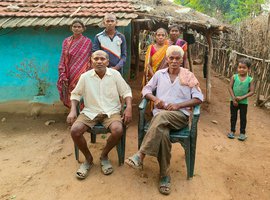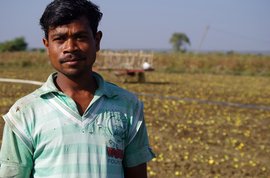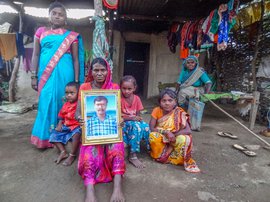When their options ran out, Vijay Koreti and his friends decided to walk home.
It was mid-April. India was under a strict lockdown brought on by the Covid-19 pandemic. And they wondered how long they could remain stranded in their small shanties in a distant land.
“Twice the police stopped our friends midway and sent them back when they tried to leave,” Koreti recalls. “But one by one they all left anyway, walking to reach home.”
The band of friends, who between them did not own a single smartphone with a GPS, had come up with a possible route:
Sirpur-Kagaznagar, in Telangana’s Komaram Bheem district, where they worked in a cotton ginning and pressing mill, falls on the Hyderabad-Nagpur railway section.
From there to Zashinagar, their village in Arjuni Morgaon tehsil of Maharashtra’s Gondia district, the distance would be 700-800 kilometres if they walked along the tracks. Gruelling, yes, but worth trying. And if they walked along the railway lines, there was less chance of them being intercepted by the police.
And so, like millions of workers across the country, Koreti, a 39-year-old, one-acre Gond Adivasi farmer – and others belonging to Zashinagar – began that arduous trek from Kagaznagar that would take them 13 nights and 14 days to reach their families back home.
It was a distance that could be covered in half a day by train or bus. But they were doing it on foot.
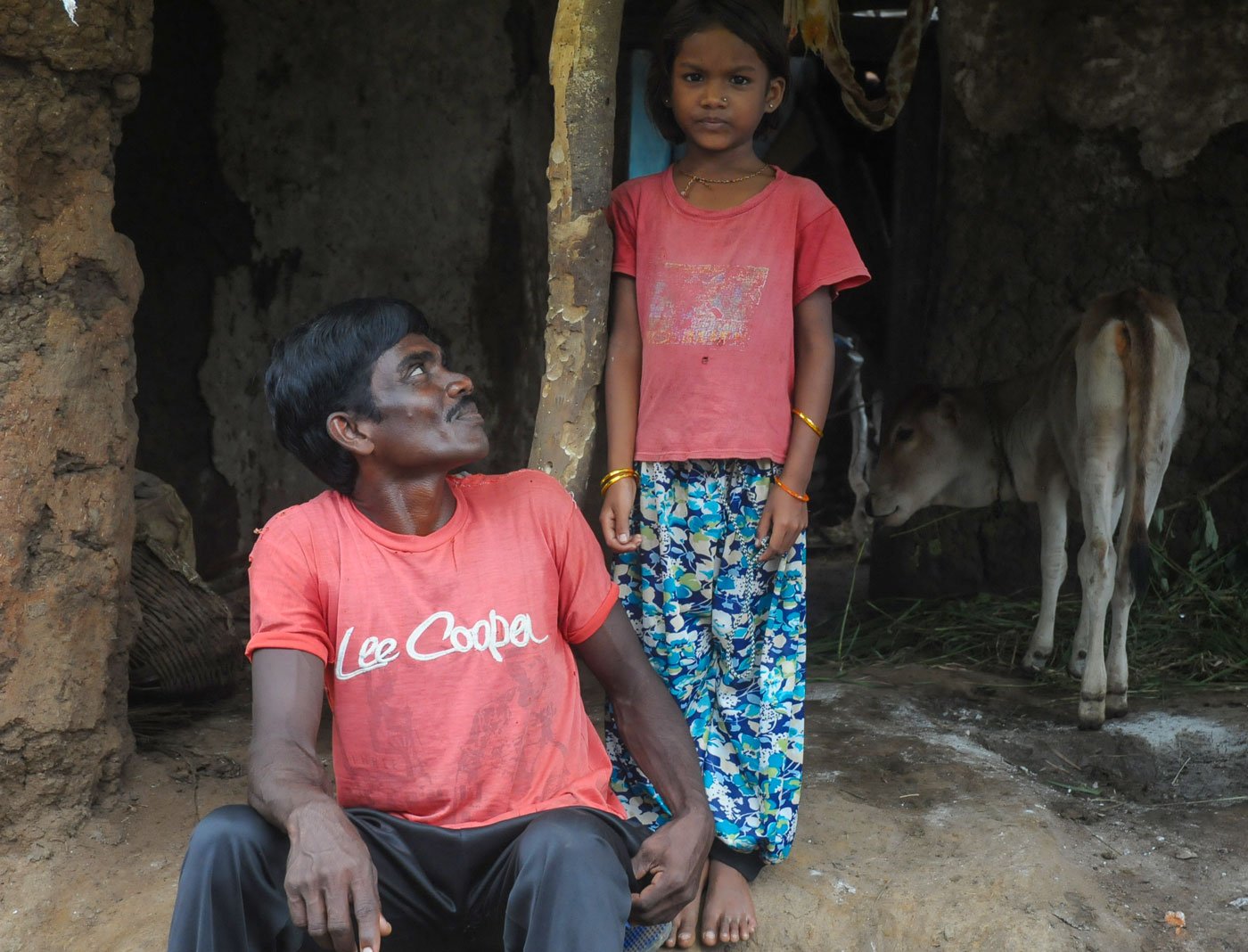
Vijay Koreti and his daughter, Vedanti, at their home in Zashinagar village, Gondia district
They split themselves into two batches. Seventeen of them, led by Humraj Bhoyar, 44, left for Zashinagar around April 13, a week earlier than Koreti and two others – Dhanraj Shahare, 30, and Gendlal Hodikar, 59.
Through all those nights and days, Koreti longed to reunite with his seven-year-old daughter, Vedanti. It kept him going. She would be waiting for him, he would tell himself and continue walking in the blazing sun with aching legs. “ Amhale fakt ghari pohchayche hote [We just wanted to reach home],” a short but stout Koreti says now, with a smile. We are meeting him and some of his friends months after their long march, on a hot and sultry day in Zashinagar, located on the fringes of the Navegaon Wildlife Sanctuary. The village has lifted the barricades it had erected to stop outsiders from entering it. But tension and fear of the pandemic still hang in the air.
***
Koreti dropped out of high school after Class 9 and had never stepped out of his village for work before 2019. He used to till his single acre, collect minor forest produce in adjoining areas, double up as a farm labourer, or go to nearby small towns for menial work in exigencies. Never did he migrate long distances for work like many others of his village.
But post the 2016 demonetisation, things dried up, and apart from a few months of farm labour, he found no other work in or around his village. Things were getting difficult on the financial front.
It was 40-year-old Laxman Shahare, his childhood friend, a landless Dalit and a veteran of labour migrations, who persuaded him to go to Kagaznagar in 2019.
Shahare has been migrating for work from his village every year since he was 18 ( see video ). When the pandemic struck, he was working as a supervisor for a businessman in Kagaznagar, managing about 500 labourers at three cotton ginning and pressing units there – with mostly male labourers migrating from in and around his native village, and from other states like Chhattisgarh.
Shahare did not walk home but returned in early June in a vehicle. However, he saw his men undertake the long walk – among them, his own younger brother, Dhanraj, who was in Koreti’s team. He himself was shuttling at the time between the mills to pay off wages, pack rations and “do whatever I could to make sure they got what they needed.”
Koreti had left for Kagaznagar in November 2019 and was to return in June 2020, in time for the kharif sowing. Depending on the hours he put in at the ginning factory, he was able to earn anything between Rs. 3,000 and Rs. 5,000 a week. When he returned home in April 2020, he did so with savings of close to Rs. 40,000 from just over five months of work at the factory.
That, he says, was more than what he would have made in his village in a whole year.
They had waited patiently in Kagaznagar for the 21-day lockdown to end and for transportation services to resume. Instead, the lockdown got extended.
The owner of the mills provided them with rations and support, but the work had been suspended. “During the lockdown, we were in a different country,” says Koreti. “There was chaos in our shanties; everyone was worried about our well-being; fear of Covid-19, too, hovered [around us]. We wondered if we should wait or leave. My anxious wife was prodding me to return.” Then, a storm blew off their shanties on the factory premises, making the decision for them.
“We started on April 20, I think,” Koreti says at his home, a beautiful mud house that he built himself.
They walked northward along the Nagpur-Hyderabad section of the north-south railway route. Crossing over to Maharashtra, they reached Chandrapur district, and then turned eastward along the new broad-gauge track for their village in Gondia, walking through the dense forests in between.
On the way, they crossed the Wardha and several smaller rivers. From where they started walking, says Koreti, their village seemed far away.
They took it one step at a time.
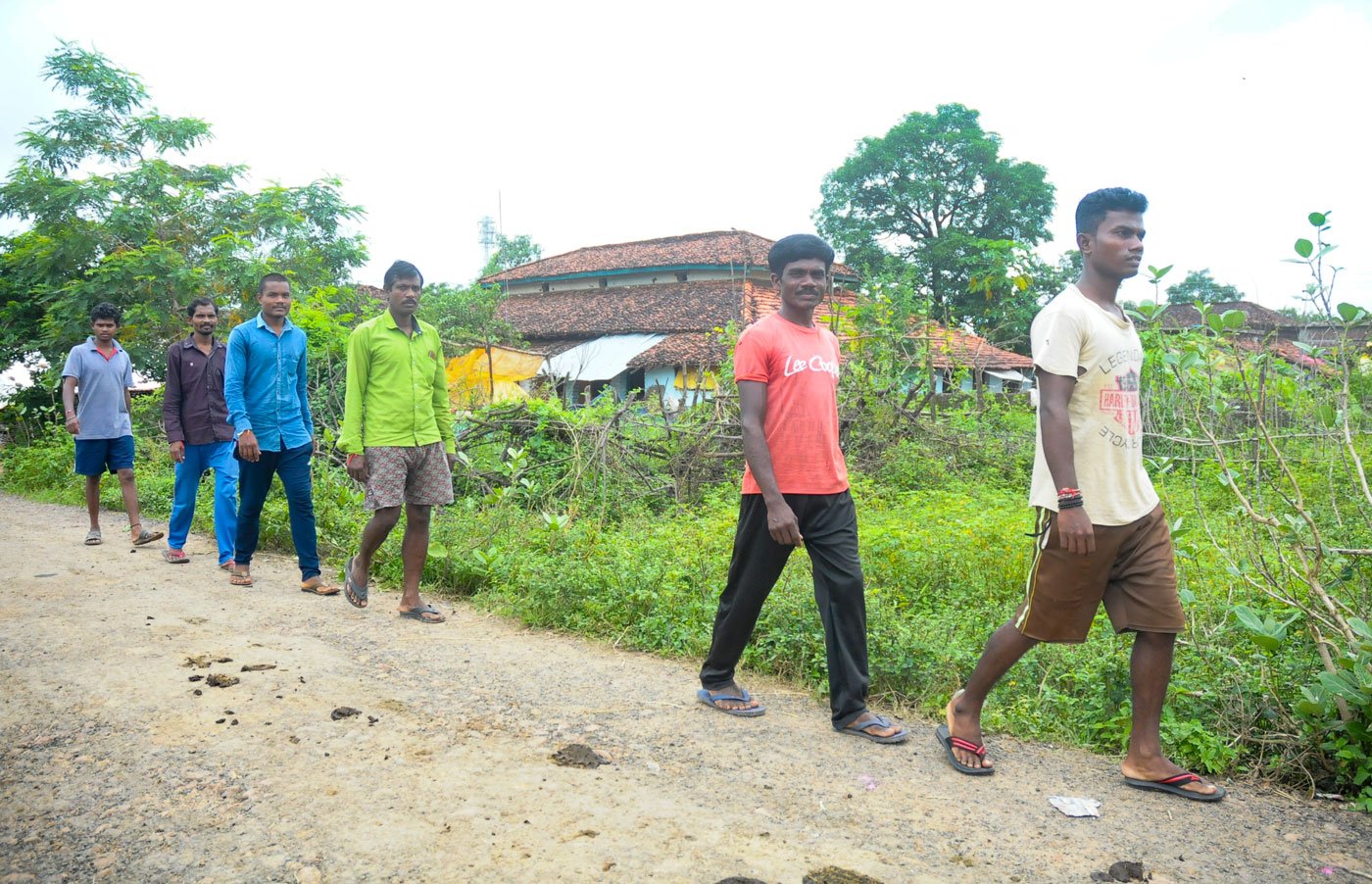
Vijay Koreti (in the red t-shirt), Laxman Shahare (in the green shirt) and others from Zashinagar travelled about 800 kilometres from Telangana's Komaram Bheem district during the lockdown
Records with the Zashinagar gram panchayat suggest that a batch of 17 men reached the village in two groups, the first on April 28. Five of them, who got separated from the 12 others, reached three days later, on May 1, as they had halted midway to recoup from their fatigue.
Koreti and his two friends reached on May 3, their legs swollen and their health having taken a beating.
When they reached Zashinagar, their footwear had worn out. Their mobile phones had long gone dead; they had had virtually no contact with their families, or friends. Along the way, they say, they saw the good and the bad of humanity – they met with railway officials, even villagers, who offered them food, water and shelter. But there were also those who denied them entry into the villages. Several, for the most part, had walked barefoot, their footwear damaged anyway. Because it was summer, they walked after dusk and rested through the hottest part of each day.
Now, in hindsight, Koreti feels that he and his colleagues need not have endured what they did, if only they had got 48 hours notice to lockdown instead of the four they were actually given.
“ Don divasacha time bhelta asta, tar amhi chupchap ghari pohochlo asto [Had we got two days’ time, we would have returned home quietly and safely],” he says.
***
On March 24, 2020, Prime Minister Narendra Modi sent the country into a lockdown at four hours’ notice, starting midnight. Though done as a safety measure to curb the spread of the coronavirus, the short notice and suddenness of it triggered panic and chaos.
Millions of migrant workers scrambled to reach their villages across India by undertaking risky journeys – countless thousands walked, hundreds hitchhiked along risky paths, rode on their bicycles or simply boarded trucks and other vehicles to reach their homes – as almost all normal means of public transport came to a standstill.
The rest of us stayed home to stave off the pandemic.
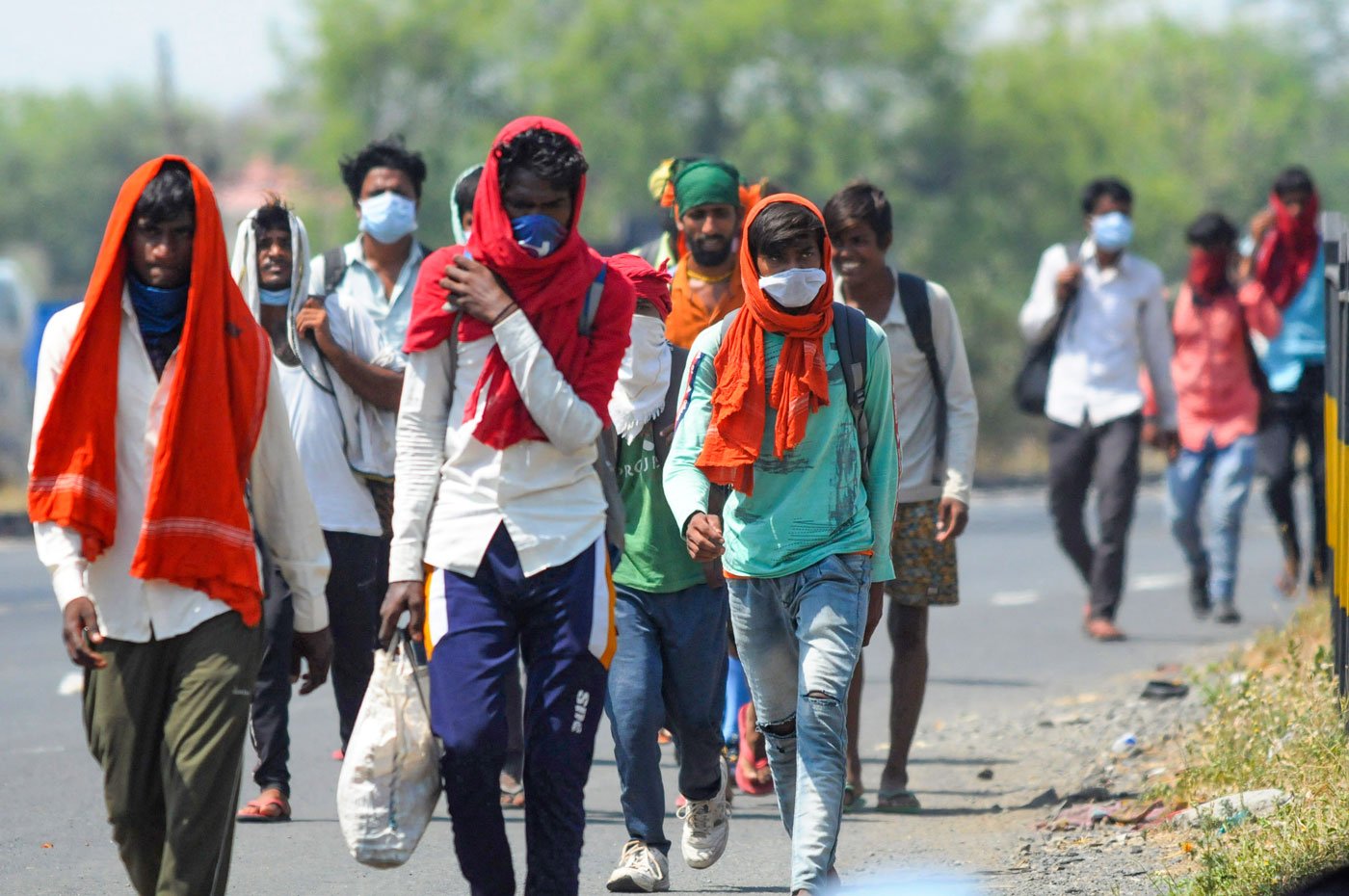
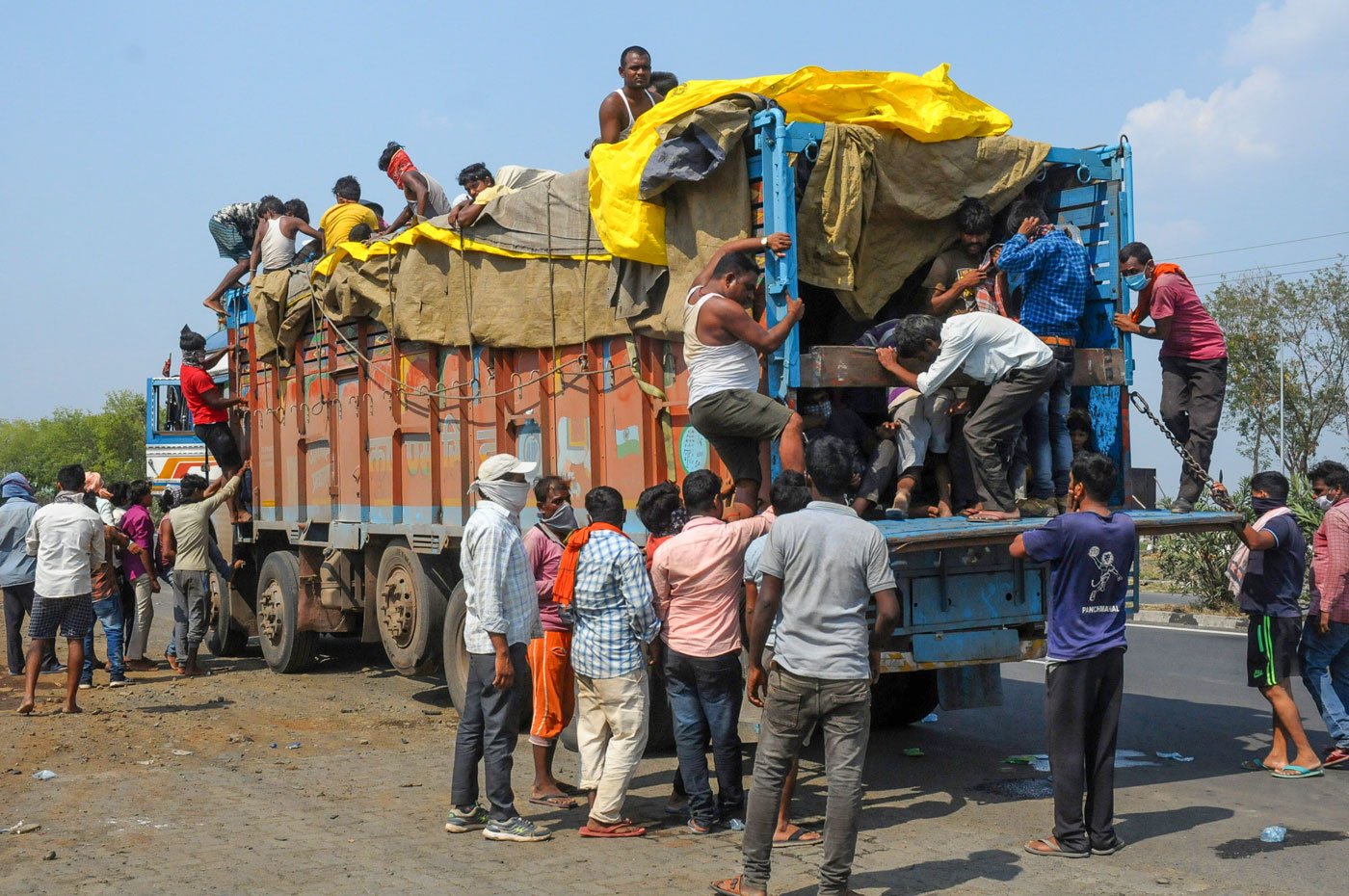
Millions of migrants walked long distances to go home; some went by trucks or other vehicles as there was no public transport
For those millions on the roads, it was a nightmare. Many poignant stories emerged on social media, and some reporters went out of their way, perhaps for the first time in their professional lives, to portray the struggles of migrants. A few commentators described the unfolding crisis as reverse migration. All agreed it was larger than the migrations India saw at the time of the bloody Partition in 1947.
At the time the lockdown was declared, there were just about 500 coronavirus cases. There were districts and whole regions that had not reported a single case. Even Covid-19 testing had yet to take off, with the Centre losing crucial time, floundering over evolving a protocol and placing the tenders and contracts for procurement of testing kits.
By the end of April, Covid-19 cases had risen by several thousand, touching a million by June-end. The health system had cracked. By the end of the current week, India will have recorded close to 11 million Covid-19 cases and over 150,000 deaths. The economy lies in tatters – a blow to the poorest, particularly the footloose migrants, already one of the most fragile groups before and during the pandemic.
***
Koreti remembers leaving Kagaznagar around 4 p.m. the first day and walking late into the night. Their luggage included of a pair of clothes, a few kilograms of rice and lentils, salt, sugar, spices, a few biscuit packets, some utensils and water bottles.
He does not remember the details now – the time, the dates or locations. All he remembers is the tiring trek.
On the road, the three of them barely spoke to one another. Sometimes Koreti walked ahead, sometimes behind the two others. They carried their belongings and rations for the road on their heads and their backs. Wherever they saw a well or borewell, they filled their water bottles to keep themselves sufficiently hydrated.
Their first stop was at a railway shelter along the tracks. The first evening, they walked some five hours, cooked food and fell asleep on a grassy patch of land.
In the wee hours the next day, they started walking again, and kept marching until the sun belched out flames. In the fields, under a tree, along the tracks, they took shelter. They walked again at the fall of dusk, ate self-cooked dal-rice, slept a few hours, and resumed their journey early in the morning, moving until the sun was directly over their heads again. The third night, they reached a place called Makodi, near the Maharashtra border.
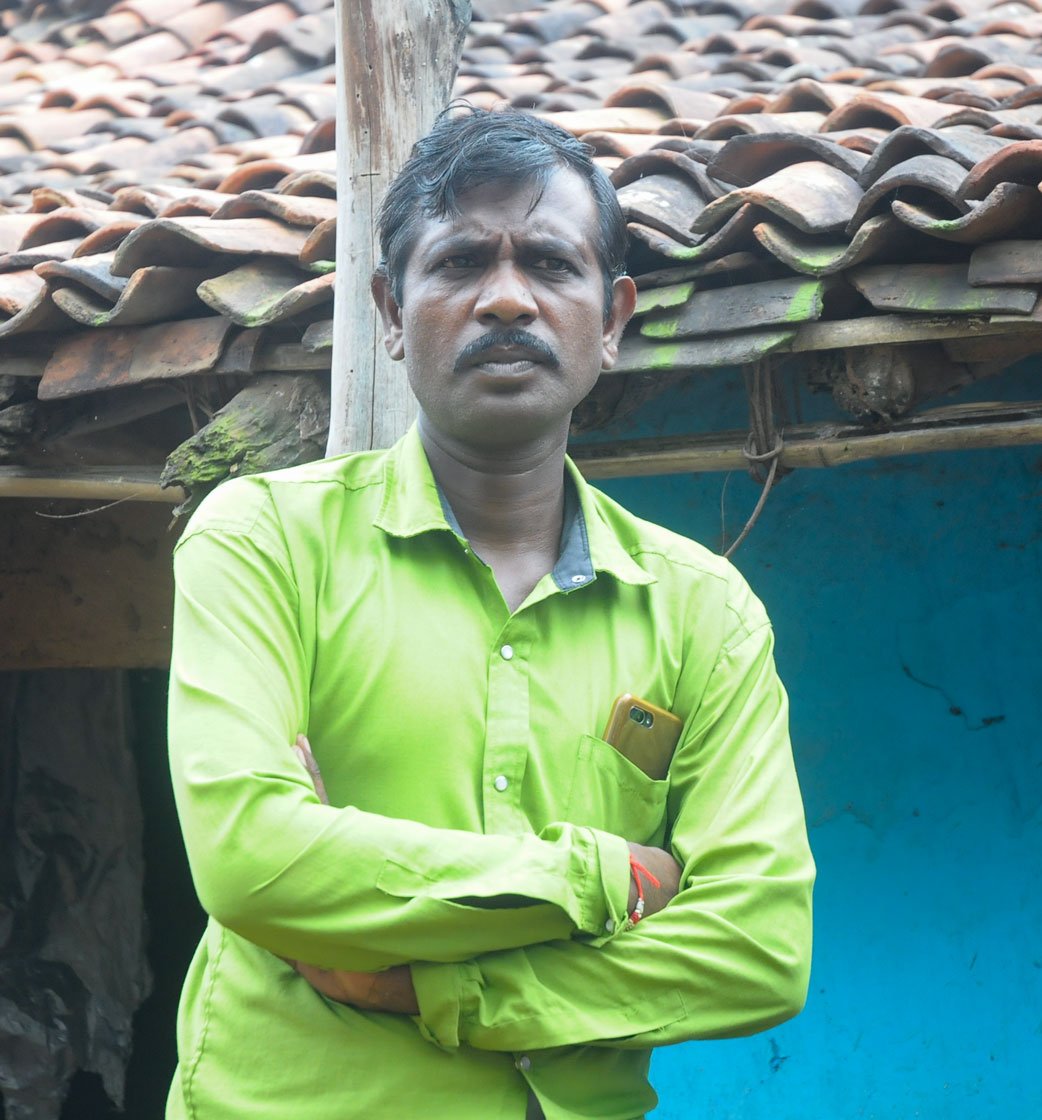
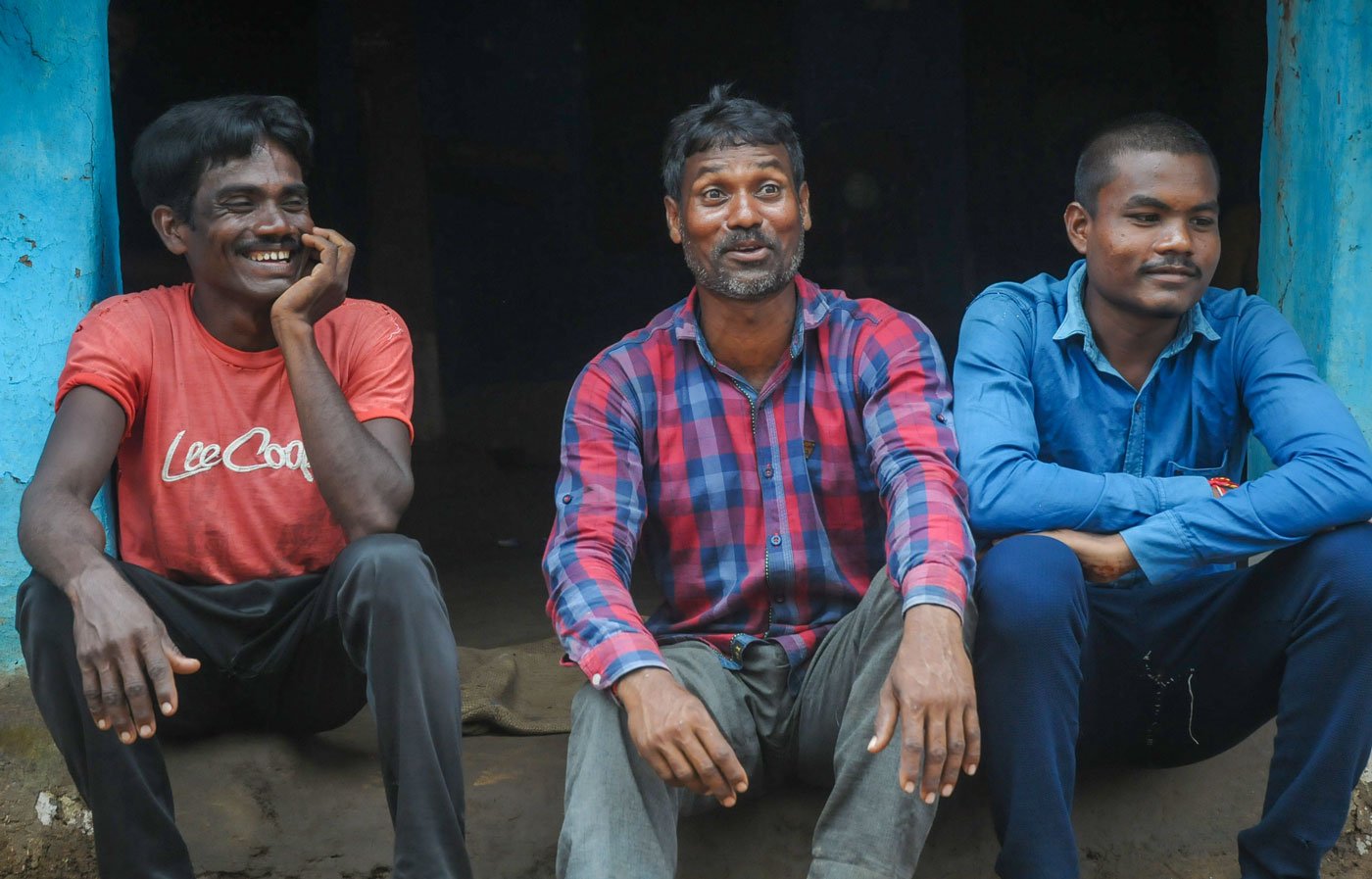
Left: Laxman Shahare has been migrating for work for more than 20 years. Right: Vijay Koreti with Humraj Bhoyar (centre) and Amar Netam (right) in Zashinagar
After 2-3 days, says Koreti, their minds went blank; they could not think.
“We kept walking alongside the railway tracks, passing villages, hamlets, train stations, rivers and jungles,” says Humraj Bhoyar, the marginal farmer who led the first group of 17 to Zashinagar.
These workers were mostly between 18 and 45 years of age. They could walk, but the harsh summer made it daunting.
Small milestones were like big achievements. They were happy and relieved when they spotted signboards in Marathi – they were in Maharashtra!
“We thought there wouldn’t be any trouble now,” Humraj recalls. Koreti and his two companions traversed the same route that Humraj’s team had walked a few days earlier, and halted at the same places.
“We stopped at a place called Vihirgaon on the Maharashtra border, and the following day at Manikgarh – a place known for a number of cement factories in Chandrapur district,” says Koreti.
The moon and stars were their companions every night they walked.
At the Ballarpur railway station in Chandrapur district, they bathed, slept the whole day and ate a sumptuous meal. The railway authorities and locals had arranged food for migrants, who were arriving there in hundreds.
“ Ase vatat hote, purra desh chalun rahila [It was as if the entire country was walking],” Koreti says. “We were not alone.” But they were mortified to see women and children, tired, fatigued, helpless. “I was happy that Vedanti and my wife, Shamkala, were at home, safe,” he says, looking at them as he speaks to us.
The next stop was Chandrapur city. There, they rested under a railway bridge and then walked along the tracks that led to Gondia. They passed Kelzar, a mofussil station in the middle of tiger territory, and then Mul, both in Chandrapur district. “It was between Kelzar and Mul that we sighted a leopard. We were sitting around a water body where it came to drink in the middle of the night,” says Koreti. Shamkala watches intently from behind him as he speaks, muttering words of gratitude to god for sending her husband home alive. “The leopard ran away into the thickets,” he says. They walked faster, fearing for their lives.
After Kelzar, they left the tracks and took the road.
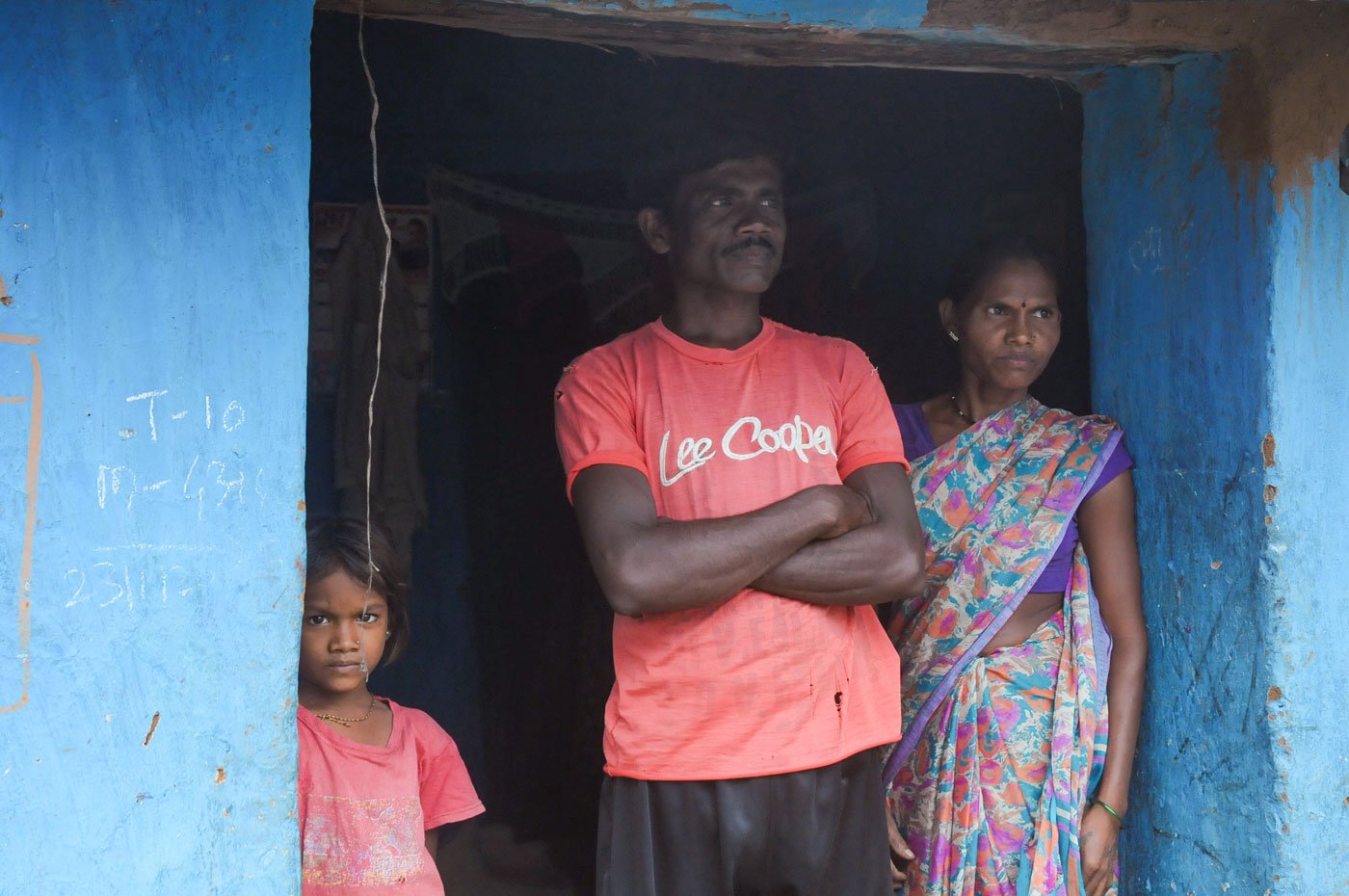
Vijay with Shamkala and Vedanti. Shamkala says she was tense until her husband reached home
The three men – particularly the older one, Hodikar, were fatigued by the time they reached Bramhapuri, a tehsil town in Chandrapur district, from where they headed for Wadsa in Gadchiroli and then took a detour to Zashinagar. Hodikar was not in the village when we visited them in September. Subsequently, we remained in regular touch with the group.
“After we reached Mul,” Koreti says, “we got to eat good food at the shelter camps locals had put up for people like us.” On the 14th day, May 3, when they finally reached Zashinagar and were welcomed by the villagers, it felt like a grand achievement.
Their swollen legs took days to heal.
“ Jawa paryant he lok ghari pohochle navhte, amhale lagit tension hote (We were under immense tension until these men returned home,” says Shamkala. “We women would talk to each other every so often and try calling their friends to see if they knew anything about their status.”
“I was in tears when I saw Vedanti,” Koreti recalls. “I saw her and my wife from a distance and asked them to go home.” He needed to avoid contact. Two schools, a big central ground and all the gram panchayat buildings had been opened up to house the returning migrants in a mandatory 14-day isolation. This was in some cases reduced to 7-10 days, in line with changing government directives and possibly because some of the returnees had had very little contact with others on their lonely journeys.
That night, in the village school where he spent a week in isolation, Koreti slept well and peacefully for the first time in many weeks. A homecoming, it was.
***
Zashinagar, originally called Tambhora, is a big village with about 2,200 residents today (1,928 in Census 2011). It was resettled at this new location after the original settlement was swallowed by the Itiadoh irrigation project in 1970. Five decades later, new generations may have moved on, but the older inhabitants who remained still struggle with lingering problems of rehabilitation and resettlement after the forced displacement.
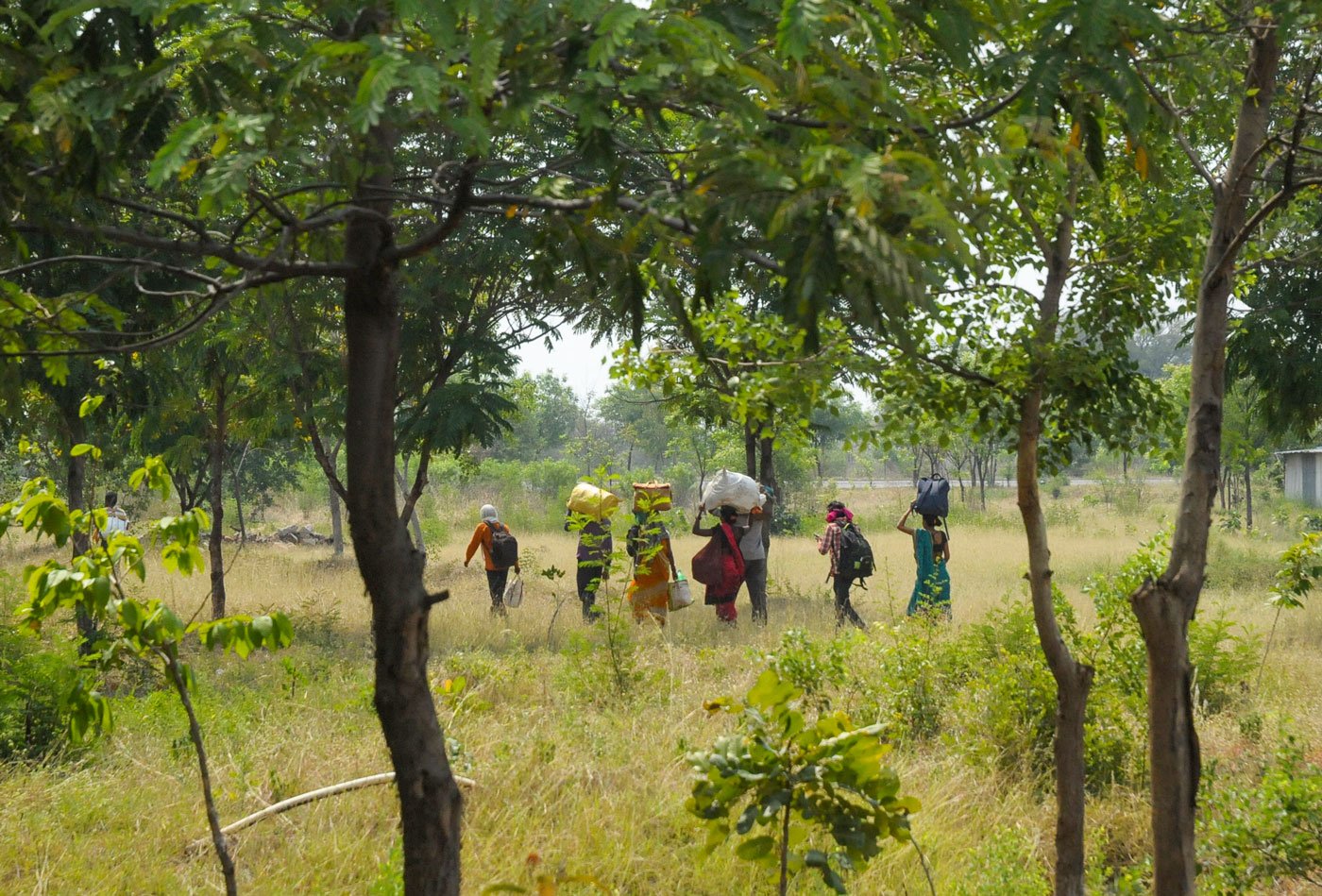
Migrant workers walked through fields, forests and along railway tracks
Tucked away in the forests surrounding the Navegaon sanctuary in Arjuni Morgaon tehsil of Gondia district, Zashinagar grapples with drinking water scarcity during the summers. Its farmers await the completion of a lift irrigation project. The village grows paddy, pulses and some coarse cereals.
Between 250 and 300 men and women of Zashinagar migrate every year to far-off places in search of work. A list of returnees maintained by the village’s Covid Management Committee since the first group of migrants returned in April records two dozen different destinations that they normally go to – from places in Goa to Chennai and from Hyderabad to Kolhapur and beyond – spread across seven states. People go to work at farms, factories, offices, roads, and send home remittances.
Eastern Vidarbha’s paddy-growing districts of Bhandara, Chandrapur, Gadchiroli and Gondia are out-migration centres. Men and women migrate long distances to work in Kerala’s paddy fields or in sugarcane or cotton mills of western Maharashtra. Some of them even go to the Andamans through a chain of labour contractors that has emerged in the last 20 years.
Among the factors driving migrations from districts like Bhandara and Gondia are the single-crop farm system and a lack of industries. Once the
kharif
season is over, landless and small farmers, who are in a majority, find little work locally to sustain them for the remaining half of the year.
“People migrate in large numbers from this region,” says Bhimsen Dongarwar, 44, a big landowner and wildlife conservationist in the neighbouring village of Dhabe-Paoni. “Migrations were on the rise [for years before the pandemic].” Most of those migrating were landless, small and marginal farmers, pushed by employment pressures – and drawn by relatively better wages to be had outside.
Remarkably – and quite luckily – even with all the migrants from far and near returning home, Zashinagar has entered the new year without seeing a single Covid-19 case right through the pandemic period – so far.
“Not a day has passed since late April without us having to do firefighting,” says Vicky Arora, a member of the Village Covid Coordination Committee. The son of a former sarpanch and an active social and political worker, he informs us that the villagers had pooled in money to look after the returning migrants spending time in mandatory isolation during the lockdown.
“We ensured that no outsider entered without permission. The village looked after the food and other requirements of the migrants, including their staying arrangements and their health check-up and Covid tests,” Arora tells us. “Not a single rupee came from the government.”
From the funds they raised, the villagers bought sanitisers, soaps, table fans, bedding and other material for returnees lodged in the isolation centres.
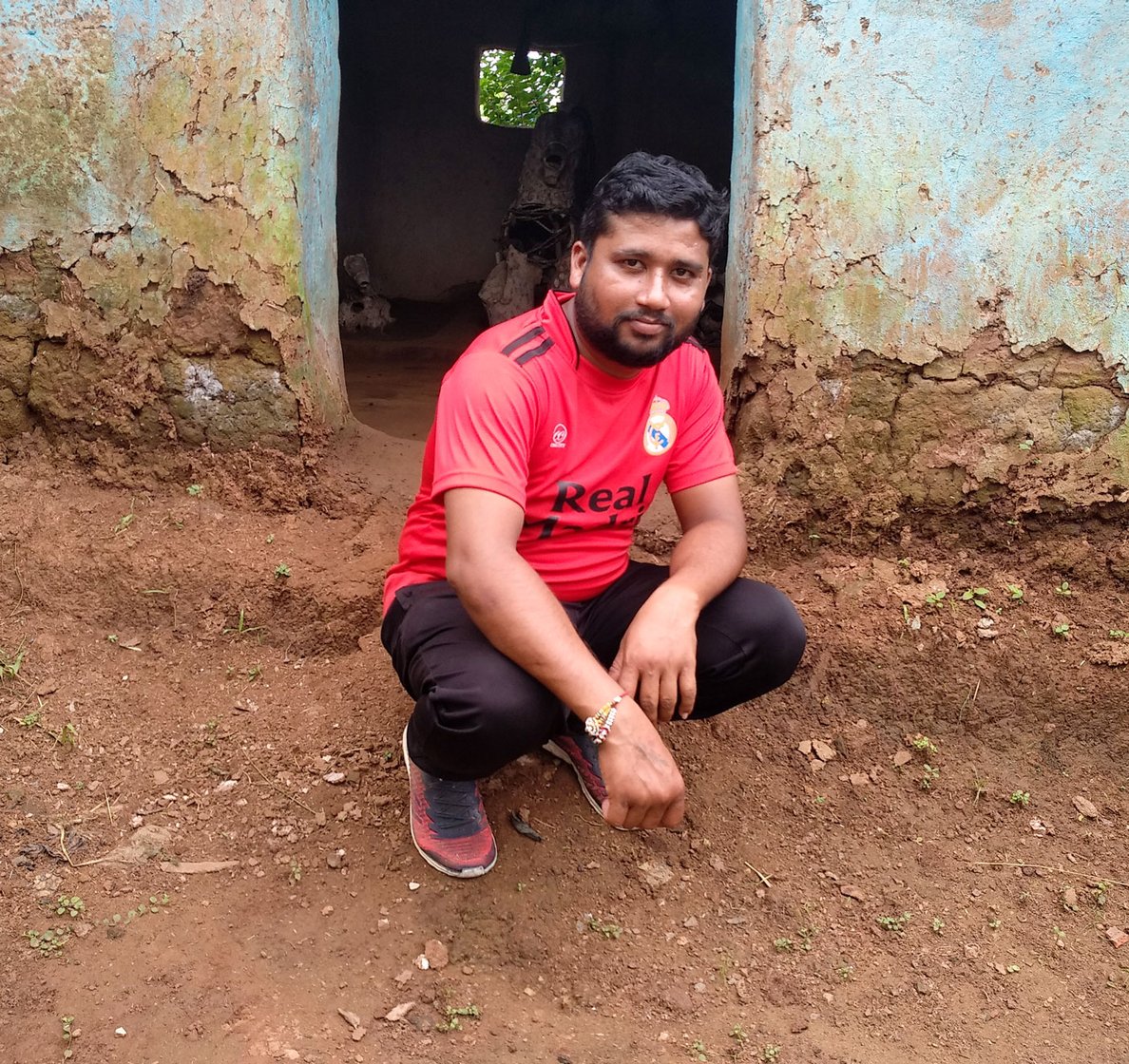
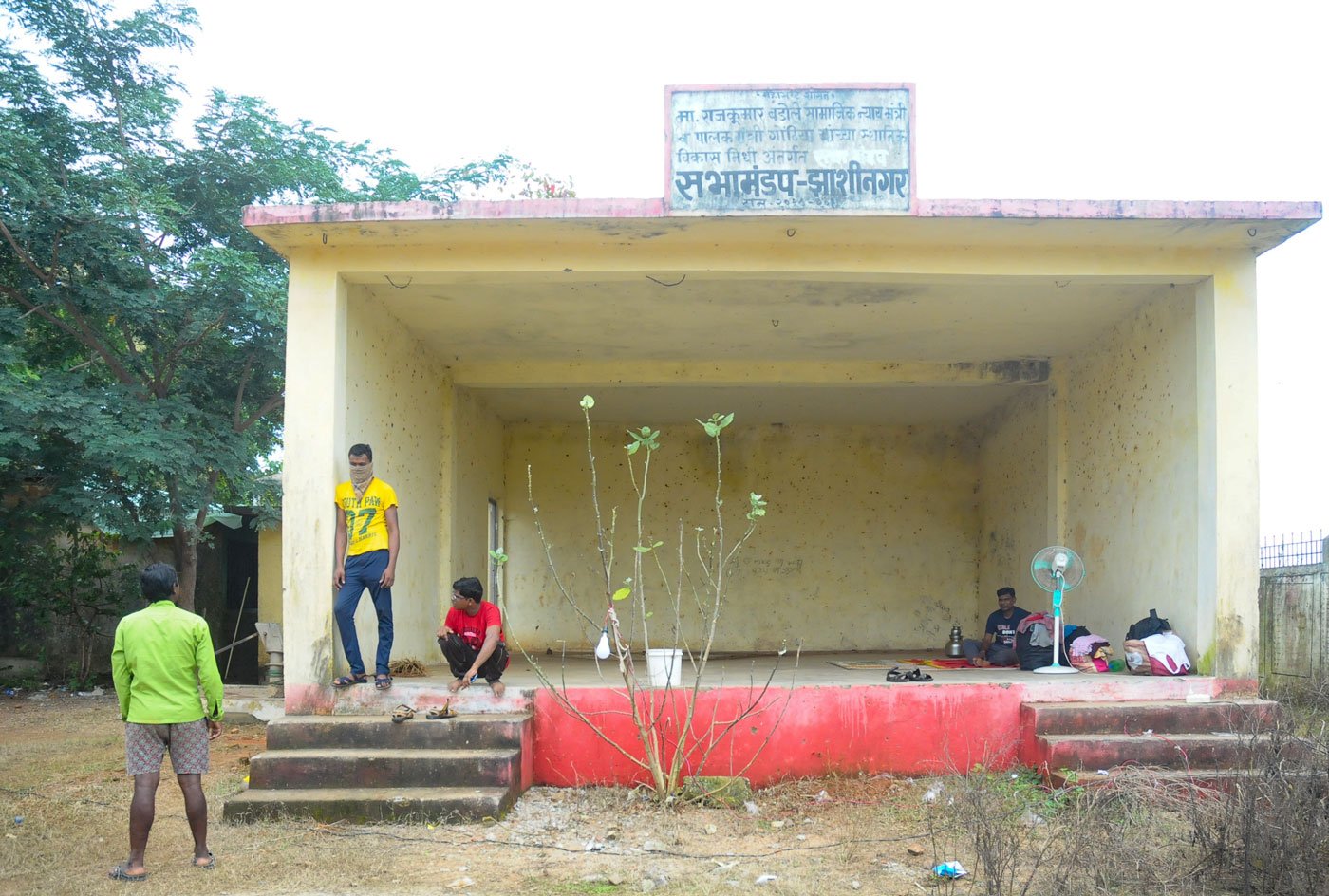
Vicky Arora (left) says Zashinagar's residents collected money to look after the migrants who spent time in isolation (right) upon their arrival home
During our September visit to Zashinagar, a group of four young migrants, who had returned home from Goa, were being put up in an open theatre overseeing the gram panchayat library.
“We came back three days ago,” one of them replied. “We are awaiting our tests.”
Who will conduct the tests, we asked.
“The Gondia health department has been intimated,” Arora informed us. “Either the villagers would need to take them to the nearest hospital or the health department would send a team to do the Covid-19 tests, after which they may go home, depending on their results.” All four work at a steel rolling mill in Margao, and have returned home on leave after a year. During the lockdown, they lived on their factory premises – and worked.
***
Presently, Zashinagar struggles with the lack of work. The panchayat meets every day. Only a few labourers have ventured out of the village these past several months after the return of Koreti and the other migrants from Kagaznagar, says Laxman Shahare.
“We are striving to create work,” says Siddharth Khadse, 51, Zashinagar’s gram sevak (village secretary). “Luckily, this year, we had good rains and farmers reaped a decent harvest. [Though, for many, a pest attack had ravaged a successful kharif yield]. But the village panchayat needs to create work so we can manage to employ some of the migrants if they stay.”
A few villagers, including Shahare and Koreti, explored other, collective options. They pooled their land, about 10 acres in all, for the rabi sowing. While that helped, there is still far less work in the village than needed – and it is unlikely many will venture out before winter of 2021.
“I won’t go out this year, even if it means living meagrely,” says Koreti. With the fear of the pandemic still looming large, this is a sentiment shared by all Zashinagar’s migrants, most of whom would otherwise have begun to leave by October 2020.
“No one’s leaving this year either,” Shahare declares emphatically, leaning into his chair. “We will live off our savings and local farm work.” The wounds of last summer still hurt. “The mill owner has been calling me to bring back the men, but we are not going.”

